Overview
Mobile native development presents a solution to the coding challenges developers frequently encounter. It offers significant benefits, such as:
- Enhanced performance
- Improved security
- Superior user experience
These advantages collectively lead to more efficient and engaging applications. How do native apps achieve this? By leveraging device capabilities, they ensure faster load times and bolster security features. This ultimately results in higher user satisfaction and retention rates, making mobile native development a compelling choice for developers looking to enhance their applications.
Introduction
In a world where mobile applications dominate our daily interactions, developers face significant coding challenges when choosing between native and cross-platform development. Have you ever wondered which approach truly maximizes performance and user experience?
Native applications are meticulously crafted to harness the full power of device hardware and software, resulting in superior performance, enhanced security, and a user experience that is both intuitive and engaging. As the demand for seamless and responsive applications continues to grow, developers are increasingly recognizing the myriad advantages of native development.
From faster load times to fewer bugs and greater scalability, the benefits are compelling. This article delves into the comprehensive advantages of choosing native mobile development, highlighting why it stands out as the optimal choice for developers aiming to create high-quality applications that resonate with users and adapt to their evolving needs.
Kodezi | Professional OpenAPI Specification Generator - AI Dev-Tool: Boost Your Mobile Native Development Productivity
Developers often face significant challenges in managing their coding tasks effectively. Kodezi's Professional OpenAPI Specification Generator directly addresses these challenges by enabling the effortless creation of standardized API documentation, which is a crucial element in mobile native development. By automating the documentation process, this tool significantly reduces the time spent on administrative tasks, allowing developers to concentrate on coding. This shift not only boosts productivity but also minimizes errors throughout the creation lifecycle.
Furthermore, Kodezi CLI serves as a versatile tool for teams, enabling them to auto-heal codebases in seconds and streamline their workflows. Recent statistics indicate that automated API documentation is becoming increasingly vital, with a notable rise in its adoption among developers in 2025. For instance, AI assists in scaling testing processes by generating test cases automatically based on recent code changes, which further enhances efficiency.
In addition, expert opinions emphasize the advantages of the OpenAPI Specification, underscoring its role in enhancing collaboration among project teams. As one developer noted, "Automated API documentation has drastically improved my productivity, allowing me to focus on building features rather than getting bogged down in documentation." A case study further demonstrated that seasoned developers gain more from AI-driven tools, indicating that Kodezi's offerings are especially beneficial for those with a strong background in the field.
Moreover, the concept of effortless deployment and parallel testing accelerates test execution, illustrating how Kodezi contributes to a more efficient and error-free development environment. Are you ready to explore how these tools can transform your coding practices? Discover the potential of Kodezi and enhance your productivity today.
Enhanced Performance: Experience Faster and More Responsive Applications
Native mobile applications are meticulously crafted for their respective platforms, enabling them to leverage device resources with remarkable efficiency. This tailored approach leads to significantly faster load times, smoother animations, and enhanced responsiveness. For instance, research indicates that native applications can achieve load times that are up to 50% quicker than their cross-platform counterparts, which directly influences user satisfaction and retention.
By enhancing code specifically for operating systems such as Android and iOS, developers unlock the full potential of the hardware, resulting in a seamless experience for users. Expert insights suggest that applications developed natively not only enhance performance but also increase engagement, as users are more inclined to return to apps that function smoothly and efficiently. As Niketan Sharma, CTO of Nimble AppGenie, states, "Native app development enables a deeper integration with device capabilities, resulting in superior performance and customer satisfaction."
Recent advancements in mobile application performance in 2025 have introduced innovative techniques that further reduce load times and increase responsiveness. For example, the incorporation of sophisticated caching techniques and asynchronous loading has proven effective in minimizing delays, allowing users to engage with applications nearly instantaneously.
Case studies underscore the tangible benefits of app optimization. One notable case involves a mobile payment tool that, after transitioning to a local development method, reported a 40% reduction in load times and a 30% increase in customer retention. This transition not only improved customer experience but also led to a significant rise in transaction volumes, indicating the anticipated growth in mobile payment solutions, projected to surge from $2.98 trillion in 2023 to $18.84 trillion by 2030.
In summary, the performance advantages of mobile native development are clear: they provide quicker load times, enhanced responsiveness, and a more engaging experience. This positions them as a preferred choice for developers aiming to optimize app performance.
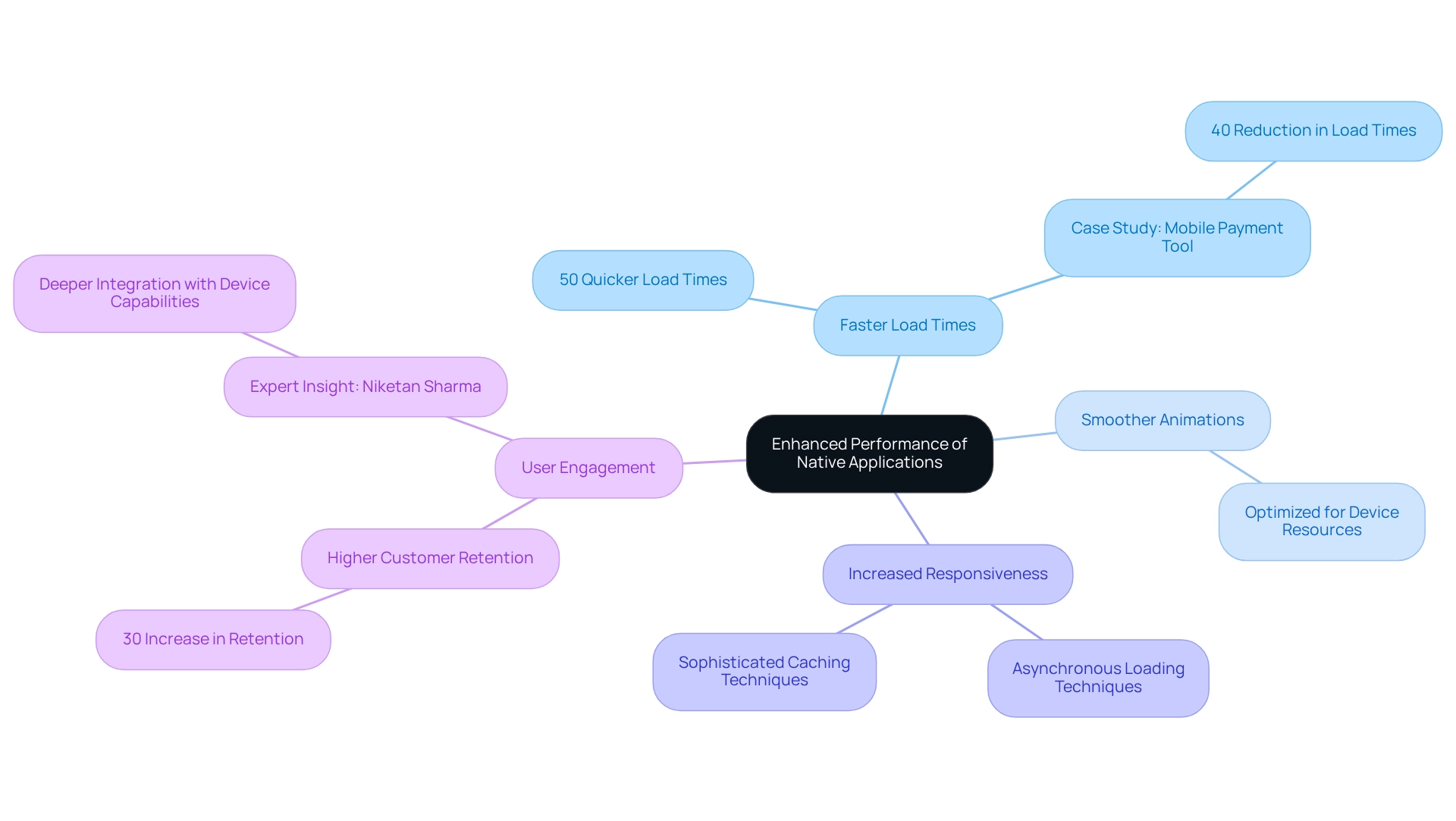
Improved Security: Leverage Device-Specific Features for Enhanced Protection
Native applications offer significant advantages through direct access to device-specific security features, such as biometric authentication and secure storage. These capabilities greatly enhance security measures that are often limited in cross-platform frameworks. A notable trend is the increasing use of biometric authentication in mobile applications, reflecting a shift towards more secure verification methods. Recent data indicates that integrating biometric technologies not only protects data integrity but also fosters customer loyalty and engagement, making it a strategic investment for organizations.
Considering the projected costs of ransomware attacks surpassing $40 billion in 2024, cybersecurity experts stress the importance of leveraging these device-specific features. Keri Pearlson, executive director of the Cybersecurity at MIT Sloan Research Consortium, asserts, "It’s impossible to be completely protected from every vulnerability." This statement underscores the critical need for developers to utilize every available security measure to effectively safeguard sensitive individual information.
As we look ahead to 2025, the mobile app security landscape continues to evolve, with an increased emphasis on incorporating robust security features directly into mobile native development software. By adopting biometric authentication, developers can create applications that not only bolster security but also enhance user experience, as consumers increasingly favor the convenience and safety of biometric verification. Case studies illustrate that organizations implementing these technologies enjoy long-term advantages, including heightened security and decreased operational costs. For instance, the study titled "Long-term Benefits of Biometric Authentication" assesses how investments in biometric technologies not only protect data integrity but also enhance user loyalty and engagement, making it a valuable investment for organizations.
Additionally, specialists like Ajay Unni highlight the necessity of preparing for potential cyber threats, emphasizing the importance for developers in mobile native development to establish robust security protocols.
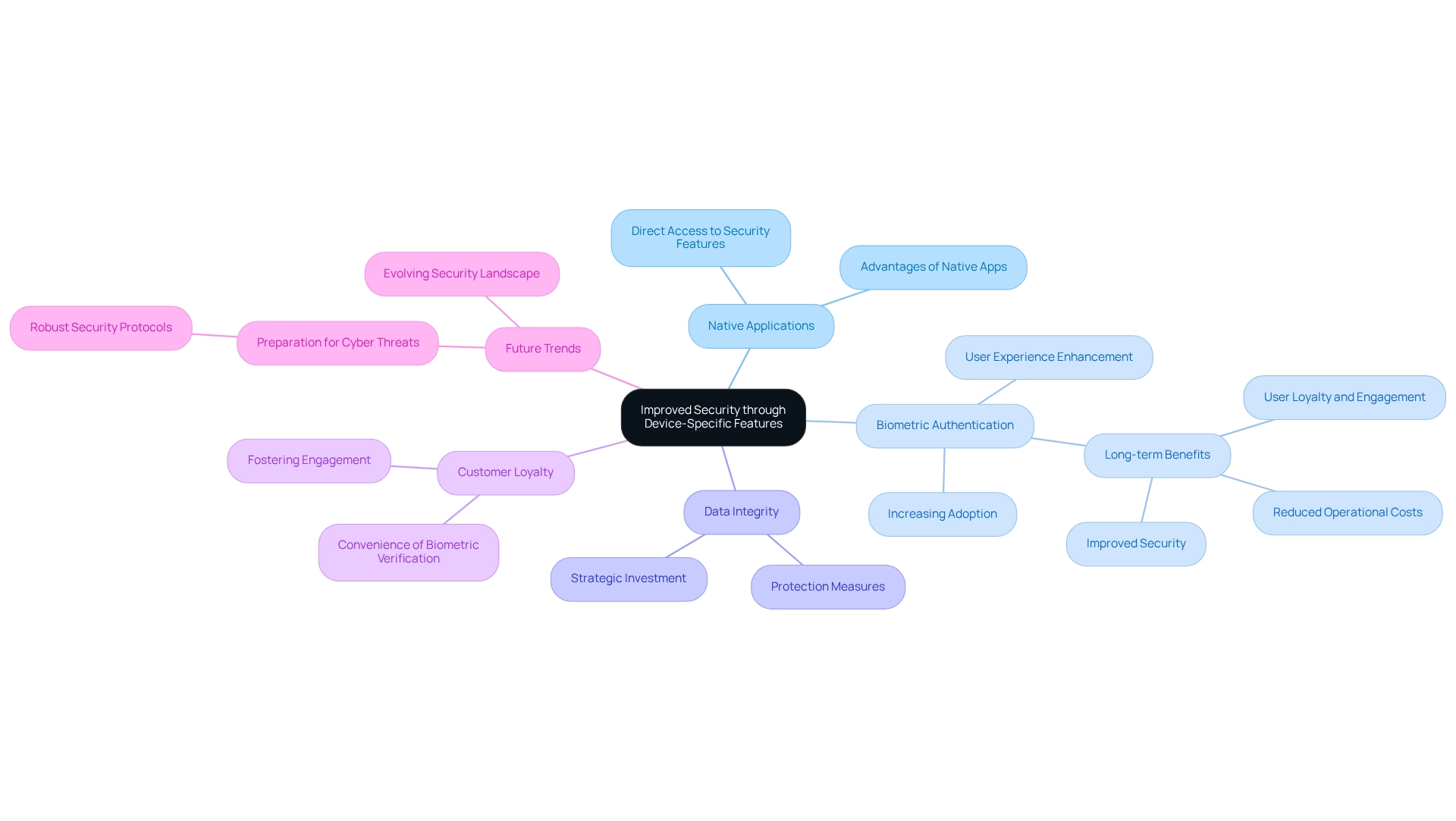
Superior User Experience: Deliver Intuitive and Engaging Interfaces
Native applications are meticulously crafted according to the specific design guidelines of their respective platforms. This careful adherence ensures seamless integration with the device's ecosystem, fostering visual consistency and enhancing familiarity. As a result, navigation becomes instinctive and comfortable. By emphasizing original design principles, developers can create interfaces that are visually striking and user-friendly, ultimately leading to greater satisfaction among users.
Recent statistics indicate that individuals feel considerably more at ease with applications that adhere to local design principles. Research demonstrates that 75% of users favor local apps for their familiarity and simplicity. Intuitive interfaces in native applications, such as those found in popular apps like Instagram and Spotify, showcase how careful design can significantly enhance user experience. As Chris Galatioto aptly states, "But when done correctly, there’s no better way to engage with your most devoted customers and expose your brand to scores of new patrons." This highlights the essential role of user involvement in app creation.
Furthermore, local applications provide performance enhancements through fine-tuning and effective resource utilization, ensuring smooth and efficient operation. As we transition into 2025, the focus on user experience for applications developed for specific platforms remains crucial. Expert insights emphasize that well-crafted apps, resulting from mobile native development, consistently surpass their cross-platform counterparts in experience ratings. This trend underscores the significance of aligning business needs with consumer expectations, as illustrated in Heady's mobile app strategy, which focuses on a strong discovery process to develop long-term mobile strategies.
Additionally, staying abreast of the latest design trends in mobile native development is vital for developers aiming to create engaging and effective user experiences.
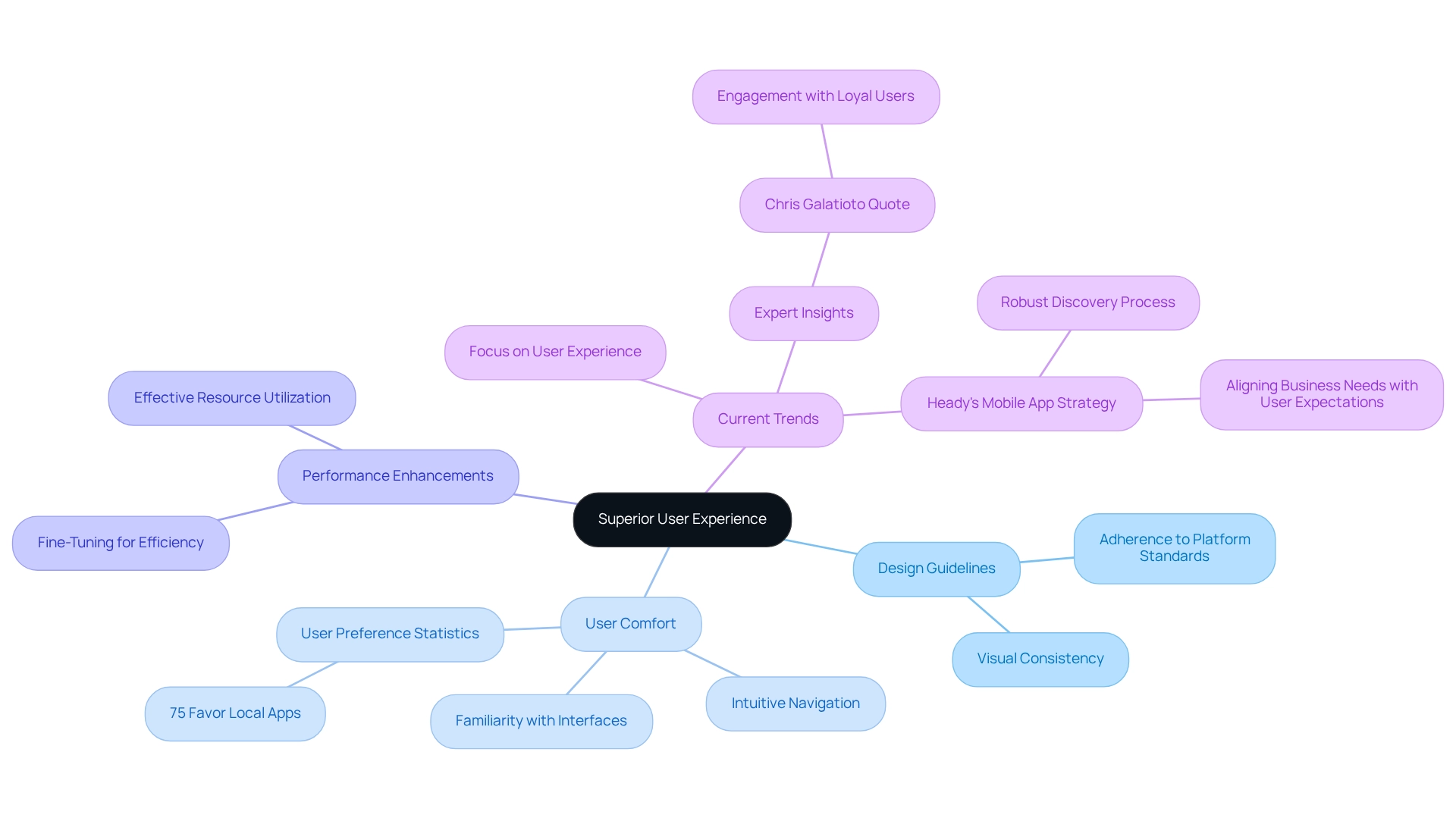
Direct Access to Device Features: Utilize Full Hardware Capabilities
Native software offers seamless access to device hardware, such as the camera, GPS, and accelerometer, which enables developers to enhance functionality significantly. Have you ever considered how fitness applications utilize GPS to accurately track your runs? Or how photography apps leverage the camera for high-quality image capture? This direct integration not only enriches user experiences but also aligns with current trends; approximately 60% of apps harness GPS features, while around 45% incorporate camera functionalities.
Furthermore, the mobile payment market is on a remarkable trajectory, projected to grow at a CAGR of 30.1%, expanding from $2.98 trillion in 2023 to $18.84 trillion by 2030. This growth indicates a rising demand for apps that effectively utilize these hardware capabilities. Developers increasingly recognize the value of these features, with many asserting that leveraging device capabilities fosters more personalized and interactive app experiences.
On average, 1,223 apps are released daily, underscoring the competitive landscape of app development and the urgency for developers to utilize device features effectively. For instance, innovative local applications are now adopting advanced techniques to optimize battery life while accessing hardware, ensuring users enjoy uninterrupted functionality. This trend underscores the importance of meticulous design in mobile native development, where utilizing device hardware is not merely a choice but a necessity for crafting engaging software.
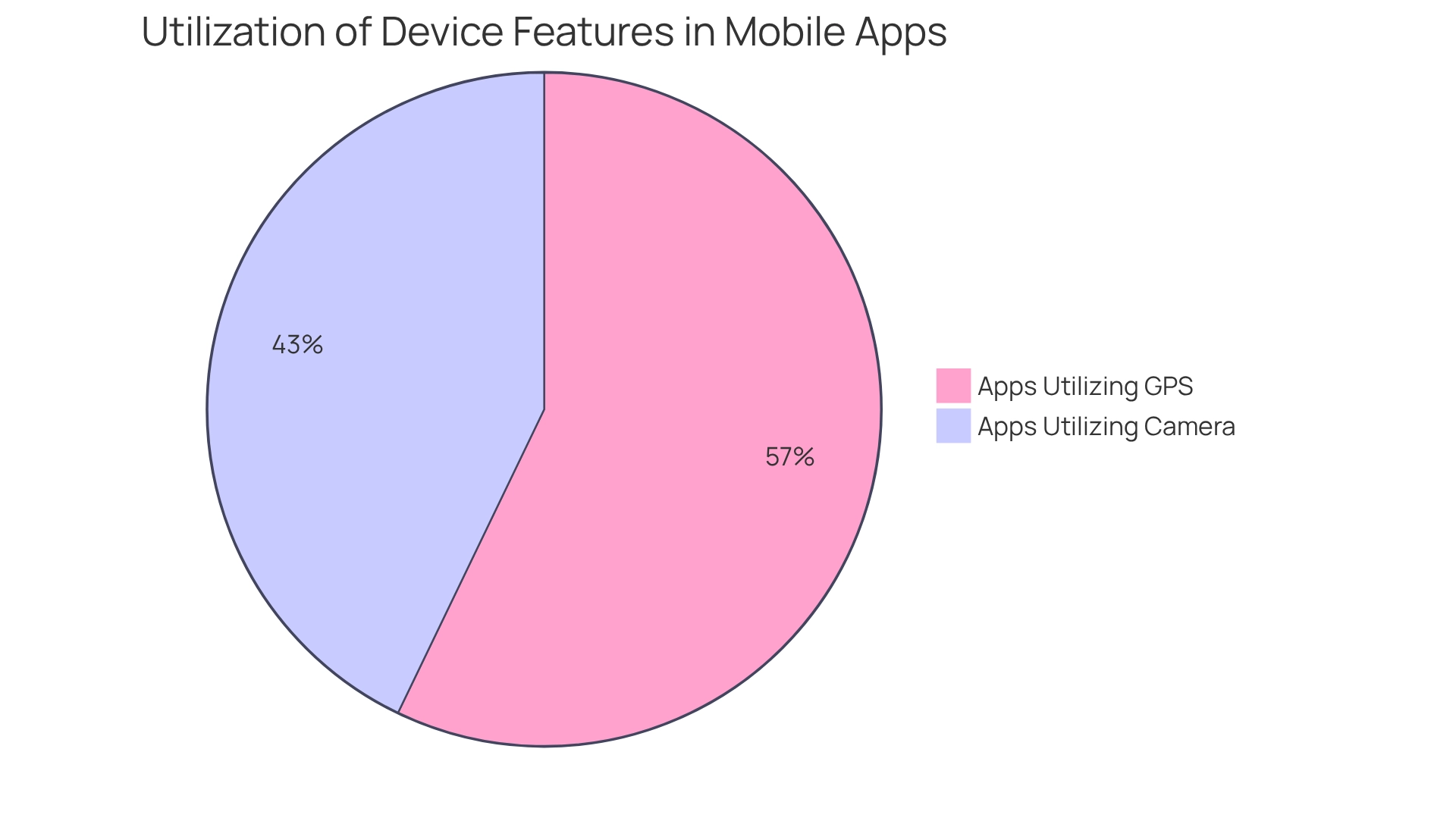
Fewer Bugs: Achieve Higher Stability and Reliability
Developers often face significant challenges when it comes to coding, particularly with bugs and compatibility issues. Native software typically displays considerably fewer bugs compared to cross-platform alternatives, primarily due to its customized design for specific platforms. This targeted development strategy allows developers to refine their code for the unique traits of each environment, effectively reducing compatibility problems and errors.
In this context, tools like Kodezi can significantly enhance the developer experience. Offering AI-driven automatic code correction and bug analysis across more than 30 programming languages, Kodezi is specifically designed for use with Visual Studio Code. With over 1,000,000 users praising its ability to simplify debugging procedures, Kodezi empowers developers to focus on crafting high-quality software while minimizing the time spent resolving issues.
Furthermore, professional insights highlight that the objective of software development is to clarify to humans what we want a computer to accomplish. This underscores the importance of clear and reliable software performance. Developers note that native software not only provides more dependable performance but also allows for better integration with platform-specific features. This capability is crucial for delivering a seamless experience, as it ensures that applications can fully utilize the device's hardware and software capabilities. Overall, the emphasis on mobile native development, combined with Kodezi's innovative features, greatly contributes to enhanced stability and reliability. This makes Kodezi a preferred choice for developers striving to excel in mobile native development and produce high-quality software. Why not explore the tools available on the platform and see how they can transform your coding practices?
Increased Scalability: Adapt and Expand Your Application Seamlessly
Native software is fundamentally designed with scalability as a core principle, enabling developers to seamlessly integrate new features and functionalities in response to shifting demands. This foundational approach guarantees that systems can accommodate increased traffic and data loads without compromising performance. With mobile devices accounting for over 60.66% of website traffic by 2022, up from 55% in 2021, the ability to adapt is essential for sustaining client satisfaction and engagement.
Developers recognize that the iterative enhancement of programs based on user feedback is crucial for long-term success. For instance, in 2024, 442 apps and games surpassed $1 million in gross revenue, underscoring the growth potential when programs are tailored to meet specific needs, largely due to their scalable architecture. Furthermore, scalability challenges continue to be a significant hurdle in mobile native development, with studies indicating that approximately 70% of developers face difficulties in effectively scaling their solutions, emphasizing the need for robust architecture to facilitate feature enhancement. Recent insights indicate that the mobile native development market is poised for continued growth in 2025, driven by user engagement and increasing downloads. By prioritizing scalability, developers can ensure their software not only addresses current demands but also remains pertinent in an ever-evolving digital landscape.
Cost Considerations: Understand the Investment for Long-Term Gains
Investing in mobile native development often involves a higher initial cost compared to cross-platform solutions. However, the long-term advantages are significant. Mobile native development typically delivers superior performance and enhanced customer satisfaction, which can lead to increased retention and engagement. Furthermore, while maintenance expenses for original applications may be lower over time due to their optimized performance and stability, the overall return on investment (ROI) can be significantly greater. For instance, companies that emphasize local creation often indicate a 20-30% rise in user interaction, resulting in enhanced revenue opportunities.
It is crucial to highlight that Progressive Web Apps (PWAs) are not found in app stores, which restricts their visibility and discoverability. This limitation further underscores the benefits of conventional apps. Developers must carefully assess these factors, including the potential for reduced churn rates and enhanced app store visibility, when determining their strategy for creating applications. As Heady states, 'Looking for an expert tech partner who’s in it for the long haul? Let’s chat.' By aligning their approach with long-term business objectives, as demonstrated in the case study 'Long-Term Mobile App Strategy,' developers can ensure that their investment in mobile native development yields substantial returns. Incorporating expert insights on cost considerations in native app creation will further enhance the understanding of this investment landscape.
Time Efficiency: Streamline Development Processes for Faster Launches
Developers often encounter significant challenges in the coding process, particularly when navigating the complexities of app launch. The efficiency of app launch processes is significantly enhanced by mobile native development, which allows developers to concentrate on a single platform. This focused method removes the complexities linked to cross-platform compatibility, leading to a notable decrease in creation time. Statistics show that original programming can result in quicker launch times, with some projects experiencing up to a 30% reduction in time-to-market compared to cross-platform options.
So, how can developers streamline their workflows? Project managers frequently emphasize the advantages of efficient workflows, observing that inherent programming allows for faster iterations driven by user input, which is essential for adjusting to market needs. As productivity author Kavitha Simha emphasizes, optimizing work-life balance in project processes can lead to greater efficiency and satisfaction. A recent case study titled "Time and Cost Analysis of Creation" revealed that teams employing original coding could reuse 50-80% of their code, leading to substantial time and cost savings. This efficiency is especially beneficial for projects with strict deadlines or financial limitations, making mobile native development an appealing choice.
Furthermore, integrating tools like Kodezi CLI, the Swiss-Army Knife for programmers, can further enhance this efficiency. By auto-healing codebases in seconds, Kodezi CLI enables teams to concentrate on creating software rather than getting bogged down by pull requests and code issues. Additionally, Kodezi Code serves as a versatile tool for enhancing programming productivity, complementing the capabilities of Kodezi CLI. Specialist views consistently confirm that prioritizing mobile native development not only speeds up the launch process but also boosts overall app performance, resulting in greater user satisfaction.
In addition, consider this thought from Norman Vincent Peale: "The really happy people are those who have broken the chains of procrastination, those who find satisfaction in doing the job at hand. They’re full of eagerness, zest, and productivity. You can be, too." By adopting local creation alongside tools like Kodezi, teams can efficiently optimize their processes, ensuring they stay nimble and adaptable in a competitive environment. Why not explore the tools available on the Kodezi platform and see how they can transform your coding experience?
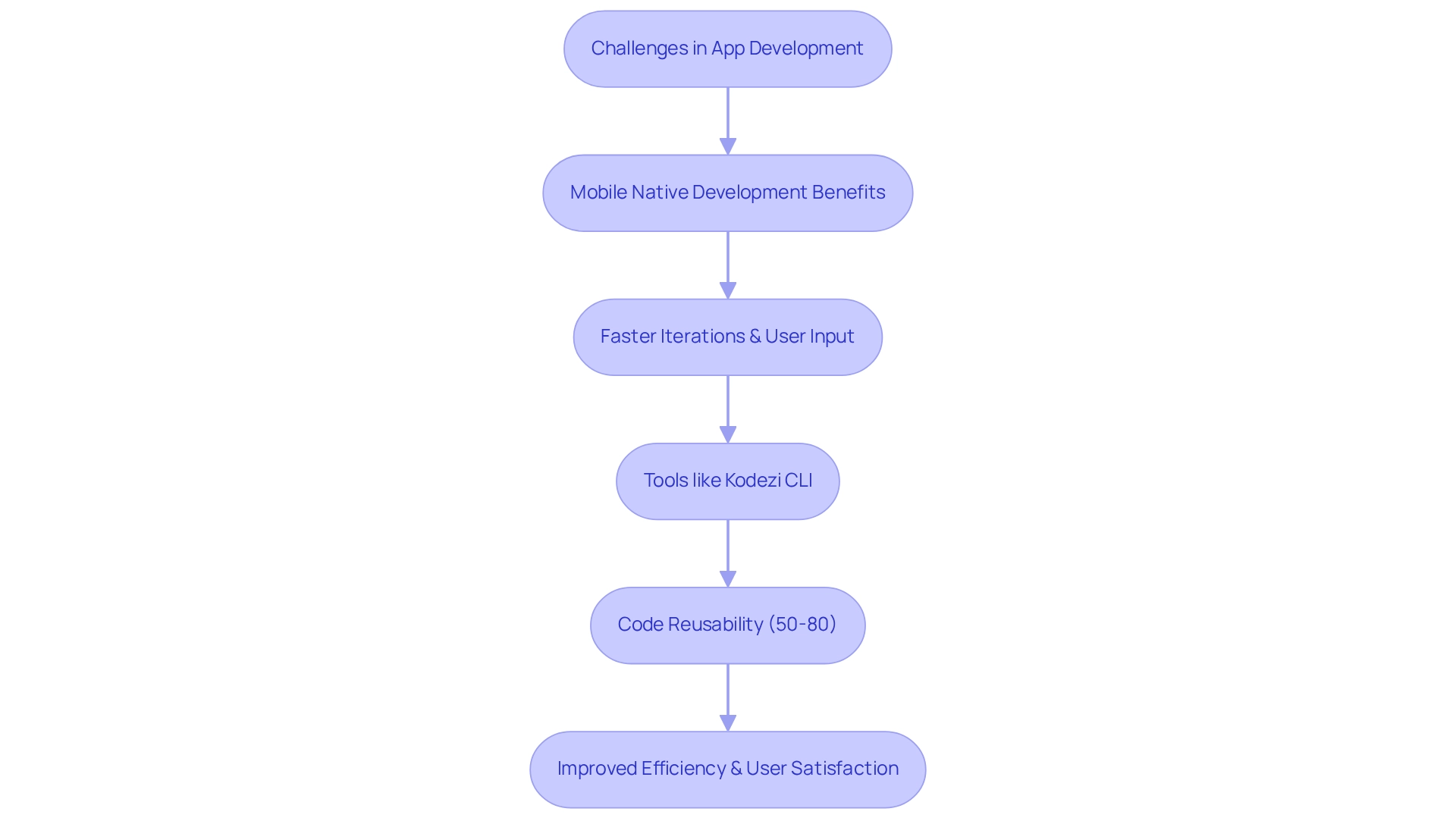
Comprehensive Advantages: Why Choose Native Development for Your Next Project
Choosing local mobile creation presents numerous benefits that significantly enhance the overall software experience. Native apps outperform competitors by leveraging the full capabilities of the device's hardware and software, resulting in faster load times and smoother interactions. Furthermore, security stands out as a critical advantage; built-in software can utilize the latest security features offered by the operating system, ensuring robust protection against vulnerabilities.
User experience improves markedly with platform-specific development, allowing apps to be tailored to meet the unique design guidelines of each platform. This customization also provides direct access to device features such as GPS, camera, and push notifications, enabling developers to craft richer, more engaging software.
Statistically, 70% of hiring managers emphasize the importance of a developer's portfolio, highlighting the value of high-quality applications in career advancement. In addition, a significant number of developers are now choosing local development for new projects, driven by the need for scalability and long-term sustainability. This trend reflects the industry's shift toward creating seamless, integrated experiences that are perpetually 'on'.
Successful case studies effectively illustrate these advantages. For example, the Tesla app empowers vehicle owners with features like remote start and climate control, contributing to Tesla's delivery of 1.31 million electric vehicles in 2022. Similarly, Uber, developed locally, manages over 15 million journeys each day, showcasing the distinct experiences achievable through local solutions.
As Sheryl Dajia noted, "Those marketers who create a full mobile experience for their consumers – with apps, optimized mobile sites, mobile loyalty programs, employing targeting like location, allowing sales on mobile devices, etc., are really experiencing the power of mobile along the purchase funnel." This underscores the importance of a comprehensive mobile strategy in enhancing engagement.
In summary, the extensive benefits of mobile native development—ranging from improved performance and security to superior user experiences—position mobile native development as a preferred choice for developers seeking to create standout applications in a competitive landscape.
Conclusion
The advantages of native mobile development are compelling and multifaceted, making it a clear choice for developers aiming to deliver high-quality applications. By leveraging device-specific capabilities, native apps achieve superior performance, resulting in faster load times and enhanced responsiveness that significantly boost user satisfaction. Furthermore, the ability to utilize advanced security features not only protects sensitive user data but also fosters trust and loyalty among users.
User experience is further elevated through intuitive and engaging interfaces designed in accordance with platform-specific guidelines. This attention to detail ensures that applications are not only visually appealing but also easy to navigate, leading to higher engagement rates. In addition, with direct access to device hardware, developers can create applications that offer rich functionalities, making them more interactive and personalized.
Moreover, the focus on fewer bugs and greater stability in native applications contributes to a reliable user experience, while scalability allows for seamless integration of new features as user demands evolve. Although the initial investment in native development may be higher, the long-term benefits, including enhanced performance, lower maintenance costs, and increased user retention, provide a substantial return on investment.
Ultimately, the shift towards native app development is not just a trend but a strategic decision that aligns with the growing need for high-performance, secure, and user-friendly applications. As the mobile landscape continues to evolve, prioritizing native development will ensure that developers can create standout applications that meet the ever-changing expectations of users in a competitive market.
Frequently Asked Questions
What challenges do developers face in managing their coding tasks?
Developers often struggle with effectively managing coding tasks, particularly when it comes to creating standardized API documentation, which is essential for mobile native development.
How does Kodezi's Professional OpenAPI Specification Generator help developers?
Kodezi's Professional OpenAPI Specification Generator automates the documentation process, significantly reducing the time spent on administrative tasks and allowing developers to focus more on coding, thereby boosting productivity and minimizing errors.
What is the function of Kodezi CLI?
Kodezi CLI is a versatile tool that enables teams to auto-heal codebases in seconds and streamline their workflows, contributing to a more efficient development process.
What recent trends have been observed regarding automated API documentation?
There has been a notable rise in the adoption of automated API documentation among developers, with statistics indicating its increasing importance in 2025.
How does AI contribute to the testing process in development?
AI assists in scaling testing processes by automatically generating test cases based on recent code changes, which enhances efficiency in the development lifecycle.
What are the benefits of using the OpenAPI Specification for project teams?
The OpenAPI Specification enhances collaboration among project teams, as it allows for better communication and understanding of API functionalities.
How does Kodezi improve deployment and testing processes?
Kodezi facilitates effortless deployment and parallel testing, which accelerates test execution and contributes to a more efficient and error-free development environment.
What performance advantages do native mobile applications offer?
Native mobile applications provide significantly faster load times, smoother animations, and enhanced responsiveness compared to cross-platform counterparts, leading to improved user satisfaction and retention.
What are some recent advancements in mobile application performance?
Innovations such as sophisticated caching techniques and asynchronous loading have been introduced to reduce load times and increase responsiveness in mobile applications.
How do native applications enhance security features?
Native applications have direct access to device-specific security features like biometric authentication and secure storage, which greatly enhance security compared to cross-platform frameworks.
Why is biometric authentication becoming increasingly important in mobile applications?
Biometric authentication not only protects data integrity but also fosters customer loyalty and engagement, making it a strategic investment for organizations amidst rising cybersecurity threats.
What long-term benefits can organizations expect from implementing biometric technologies?
Organizations that adopt biometric technologies can enjoy heightened security, decreased operational costs, and increased user loyalty, contributing to overall business success.




